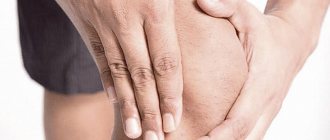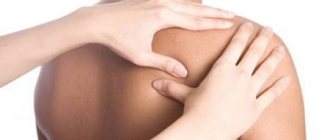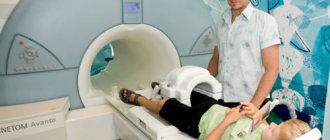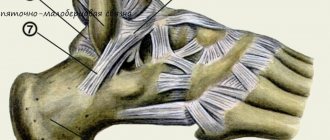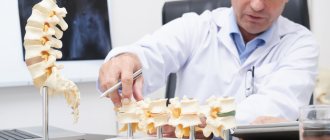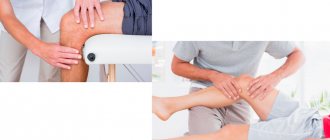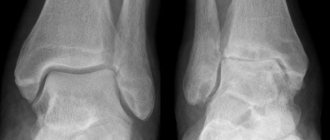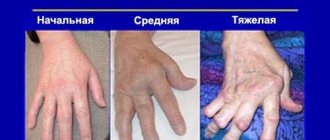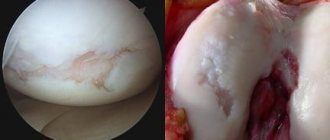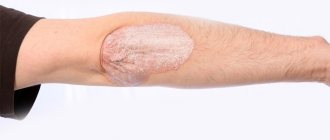Arthritis in the ankle joint is a serious disease that, without treatment, can cause complete immobility of the joints due to the destruction of the cartilage shell and the proliferation of the bone surface. The first symptoms of inflammation cannot be ignored. It is important to determine the type of arthritis for treatment to be effective. Moreover, it is not just a disease of the elderly; children are also susceptible to ankle inflammation due to injury or infection.
ICD-10 code
In the International System of Classification of Diseases, arthritis has many codes depending on the cause and characteristics of its course - from M00 to M25. For example, M00-M03 is the section “Infectious arthropathy”, M05-M14 is “Inflammatory polyarthropathy”. And ankle arthritis can fall into any of the groups.
Attention! Remember that during inflammation, the joints are gradually destroyed. If treatment is neglected, complete deformation or fusion of the articular surfaces occurs.
Diagnostics
Treatment of any disease begins with diagnosis. This makes it possible to identify the exact cause of the ailment and eliminate suspicion of the presence of other pathologies similar in clinical picture. For example, arthrosis, arthropathy (a complication that develops into a separate disease) and arthritis of the joint have many similar features. By the way, it is possible that this trio affects the body in parallel to each other.
So, diagnostics includes:
survey conducted by the attending physician. During it, the patient’s complaints and the nature of their manifestation are clarified;- laboratory research. Based on the results of the OAC and OAM, the presence of an inflammatory process in the body is revealed. Unfortunately, it is impossible to determine its localization using this method;
- blood immunology. This test determines what antibodies the body has to fight infection. He will point you in the right direction for therapy;
- blood biochemistry. It helps to establish an accurate diagnosis;
- X-ray. Helps differentiate ankle arthritis from other ankle diseases. Has significant flaws (does not show soft tissues and ligaments);
- MRI, CT and ultrasound. The most effective methods for diagnosing the disease. They allow you to begin treatment for ankle arthritis, having full information about the patient’s condition in the problem area. CT is more often used when MRI cannot be used. Using ultrasound, specialists look at how much the joint cavity and the soft tissues close to it have changed;
- arthroscopy. It represents a compromise between the diagnostic process and the implementation of therapeutic actions. It is performed through surgery. Its implementation is determined by such positive aspects as examination of the internal state of articular cartilage; removal of the consequences of the inflammatory process, for example, fluid (if any); stop bleeding.
How is it different from arthrosis?
Arthritis is often confused with arthrosis. It's not the same thing. With arthritis, an inflammatory process of various etiologies occurs, which involves all the forming parts of the joint (bones, membranes, cartilage, joint fluid, ligaments). Functioning is impaired, the joint is deformed. The picture shows the destruction of cartilage (using the example of the knee).
Arthrosis is characterized by the destruction of cartilage caused by irreversible reactions in the body. This is a chronic disease associated with metabolic failure or injury. Osteoarthritis causes irreversible changes in the structure of the joint.
Diet
Patients with arthritis are given a special therapeutic diet. It is known that canned foods, pickles, smoked foods, and nightshade vegetables can lead to an exacerbation of the disease and delay treatment, so they must be excluded from the diet.
For arthritis, a diet is recommended that will be aimed at reducing acidity in the body. To do this, you need to eat more fruits and vegetables in the form of salads, stews or boiled. The more severe the stage of arthritis progression, the more strictly the diet should be recommended for the patient. As a rule, in severe forms of the disease, patients need 3 meals a day, consisting only of raw vegetables. The diet is indicated for a course of 7 days and, if necessary, can be repeated after several months.
A diet is quite effective, with the help of which salt deposits can be pulled out of diseased joints. In this case, pre-soaked rice is boiled and washed until the mucus is completely removed.
For this category of patients, there is also a list of prohibited foods, which includes everything that includes excessive amounts of animal fat, hot spices and salt. In addition to these, it includes:
- alcoholic drinks and soda;
- intensively brewed black tea;
- cocoa and coffee;
- grapes of all varieties;
- berries, in particular raspberries;
- mushrooms and so on.
Causes of ankle arthritis by type
There are many causes of inflammation. They are varied and, most often, fit a certain type. The following main joint lesions are distinguished:
- gouty;
- post-traumatic;
- rheumatoid;
- reactive;
- load (traumatic).
Inflammation manifests itself in acute or chronic form.
Gouty
It occurs when the level of urea in the blood is elevated. The reasons for this inflammation:
- Arthrosis of the ankle joint - causes, symptoms, diagnosis, degrees of disease and treatment
- metabolic disorders in various organs and systems;
- constant use of alcohol;
- poor nutrition.
When the level of uric acid in the blood is high, the body does not have time to completely eliminate it. Salts gradually accumulate in tissues, causing inflammation. A creaking sound appears when the foot rotates. It becomes difficult to walk. The ankle area turns slightly red.
Rheumatoid
This type is classified as a systemic disorder of the body; the development of the disease depends on genetic predisposition. In this case, the joint swells slightly. Aching pain periodically occurs in the inflamed area.
Post-traumatic
Various injuries contribute to the appearance and development of arthritis:
Guys! We launched an author community on the topic of health, fitness and longevity. Let's build an ecosystem together that will make us develop, no matter what! Join if you care about your health!
- dislocations, fractures;
- severe bruises;
- sprained or torn ligaments.
When damaged, blood can enter the joint cavity. This causes an inflammatory process.
Load
Constant heavy loads on the foot cause microtrauma. Various factors can lead to stress arthritis:
- permanent long-term mechanical damage to tendons and connective tissues;
- high load on ligaments;
- walking in high heels (especially unstable stiletto heels).
As a rule, stress arthritis occurs in athletes: hockey players, skiers, runners, figure skaters. They have a very strong load on the ankle.
Reactive
It develops during various infections that occur outside the joint area:
- upper respiratory tract infections;
- inflammation of the genitourinary system;
- intestinal infections.
Connective tissues are attacked by harmful bacteria, which activate the infection. The development of the disease is accompanied by stiffness during movements and periodic dull pain in the affected area.
- Arthrosis-arthritis of the ankle joint
In addition to the main reasons inherent in a certain type of arthritis, there are risk factors that give impetus to the development of ankle inflammation:
- overweight (obesity). Extra pounds increase the load on the joints and also provoke a failure of metabolic processes;
- flat feet. Violation of the correct position of the foot increases the load when walking, which subsequently leads to the onset of inflammation;
- hormonal disorders;
- weak immunity;
- allergic reactions;
- bad habits.
Uncomfortable or tight shoes can lead to the development of chronic arthritis. Ankle problems can also develop as a result of other diseases. For example, with autoimmune disorders, psoriasis or scleroderma, arthritis is a concomitant pathology.
Acute purulent
If an infectious lesion of a joint is left untreated, acute inflammation may develop with the accumulation of pus in the joint cavity. In most cases, the disease is caused by staphylococci or microbial flora that penetrated from the genitourinary system.
Remember! Signs of acute purulent arthritis - joint pain and swelling, fever and weakness, chills and sweating - require immediate medical attention.
How does atrosoarthritis of the ankle joint manifest?
Pain, fever and stiffness are signs of arthritis
Pathology of the ankle joint develops over time, usually manifested by an inflammatory process in other joints.
The main symptoms that should attract attention:
- The presence of pain that increases with activity and is felt in the ankle area;
- Accumulation of fluid, during which edema forms;
- Inconvenience while moving;
- Redness of the skin in the joint area, caused by blood vessels overflowing, as well as an increase in body temperature.
The acute form of the disease is characterized at first by weakness, loss of strength, increased body temperature, and the presence of pain in the lumbar region.
Factors influencing the development of the disease in children
Symptoms of inflammation are similar to “adult” manifestations of the disease. At the initial stage, they are easily confused with an ordinary injury or fatigue. It is difficult for a child, especially a small one, to explain his condition and pinpoint the exact location of the pain. Therefore, the baby’s complaints that his legs hurt and his reluctance to walk cannot be ignored.
Any minor foot injury in a child can lead to serious disorders and, in the future, cause inflammation. If you experience the slightest pain, swelling in the foot area or redness, you should immediately consult a doctor.
In childhood, the development of inflammation in the ankle can be affected by:
- ARVI, especially accompanied by complications;
- viral flu;
- untreated sore throat;
- stomach or intestinal infections (dysentery, helminthiasis);
- allergies (to dust, wool, food);
- foot injuries left unattended.
In addition, the appearance of arthritis of the left or right ankle joint is influenced by such factors as living conditions: whether there is adequate nutrition, whether the emotional situation in the family is comfortable, whether the child’s shoes are comfortable, whether the load on his feet is increased.
Any injury in combination with infection or other internal disorders can provoke inflammation in the joint. So watch the video about preventing ankle sprains.
Symptoms of ankle arthritis
Inflammation occurs in two forms:
- Arthritis of the ankle joint: causes, symptoms, effective methods of traditional and traditional medicine
- acute;
- chronic.
The main symptoms depend on the severity. In the acute form, clinical manifestations are as follows:
- the joint swells quickly;
- the tumor spreads to the entire foot;
- body temperature rises;
- with purulent inflammation, the joint area turns red;
- any movement is accompanied by pain, it is especially difficult to step on the foot.
When joint damage develops gradually over a long period of time, the disease enters the chronic stage, which is characterized by periods of exacerbation and remission. The following symptoms accompany inflammation:
- aching pain, a feeling of numbness in the foot, which worsens in the morning;
- if inflammation progresses, swelling appears. The ankle area may become red.
The initial stage of the process is indicated by the following signs:
- familiar shoes begin to pinch;
- joint mobility is impaired;
- foot movements, especially sudden ones, are very painful.
An acute form of inflammation develops with various infections, most often it occurs in a reactive form. The inflammation can be purulent; it covers the entire joint and connective tissues, accompanied by the development of phlegmon.
In the chronic stage, it often occurs:
- burning sensation in the foot, with an increase in temperature in the affected area;
- the appearance of swelling, roughening of the skin;
- deterioration of health (discomfort, fatigue).
With an advanced form of inflammation, muscle atrophy and deformation of articular joints occur. This occurs due to lack of mobility and reduced load on the affected ankle, as well as due to the overgrowth of bone tissue.
Treatment options
Treatment is carried out comprehensively
Treatment for arthrosis in the ankle joint depends on the site of the disease and involves an integrated approach using medication and physiotherapy.
Drug treatment
Drugs used to combat inflammation and help reduce pain.
NSAIDs and glucocorticosteroids will help neutralize pain and also relieve inflammation of the ankle joint. Non-steroidal anti-inflammatory drugs - Diclofenac, Aceclofenac, Nimesulide, Butadione, Meloxicam, Piroxicam, Naproxen, Indomethacin. Such medications are available in the form of tablets, ointments, gels for the purpose of treating chronic types of disease, in the form of capsules for intramuscular administration to relieve severe attacks of pain.
Treatment of arthrosis of the ankle joint based on NSAIDs can be carried out throughout the entire course of the disease, due to the absence of their negative impact on the gastrointestinal tract.
Long-term use of indomethacin can trigger the destruction of cartilage tissue.
Steroid drugs are considered highly effective, with their help it is possible to achieve good results in the fight against diseases of the musculoskeletal system, but they have a number of negative aspects that can affect the hormonal system, the condition of muscles, skin, gastrointestinal tract organs, as well as be a focus for the development of a disease such as osteoporosis. In this regard, doctors rarely prescribe corticosteroids, only in situations where the patient significantly needs them:
- Lack of effectiveness of treatment with NSAIDs;
- The body's immunity to other medications, which may cause an allergic reaction;
- Complications and side effects appear that affect internal organs;
- The condition of the disease is worsening.
Preference may be given to medications such as Prednisolone, Methylprednisolone and Betamethasone. They are produced in the form of tablets or capsules for intravenous or intra-articular administration.
Basic drugs
Basic medications will help reduce the area of inflammation, as well as stop the degeneration of cartilage tissue. This group of drugs is characterized by a long course of treatment, due to the fact that a change or improvement in the condition can only be noticed after several months.
First-line drugs include Methotrexate, Sulfasalazine and Leflunomide. They prevent the spread of cells in the affected area and prevent changes in the integrity of the joint and connective tissues.
Second-line drugs include: Azathioprine, Cyclosporine and gold salts (Tauredon, Auronafon), which contain more harmful substances, and therefore are prescribed only during exacerbation of the disease. Basic agents can be taken individually or together for complex treatment.
Chondroprotectors
Chondroprotectors are used to restore connective tissue between joints. These include: chondroitin and glucosamine. Drugs in this group (Teraflex, Alflutop, Dona, Structum) are characterized by a long course of treatment, since the effect is noticeable only after several months. They are prescribed in the early stages of arthrosis, since with complete thinning of the cartilage tissue this method is ineffective.
Microcirculatory drugs
Microcirculatory preparations are used to restore proper blood circulation in the ankle joint and saturate the cells with the necessary oxygen. Among them are: ATP, Nicotinic acid, Heparin, Troxevasin, Actovegin, Angiotrophin, Contrical.
Physiotherapy and exercise therapy
With the synchronous development of arthrosis and arthritis of the ankle joint, patients are recommended procedures with a physiotherapeutic approach, and the severity of the disease must be taken into account.
When the synovial membrane is damaged, electrophoresis with Hydrocortisone, Papaverine, and phonophoresis with Analgin are used.
In case of complete destruction of the synovial membrane, the following measures apply:
- Taking baths with dissolved radon and turpentine;
- Ultraviolet irradiation;
- Ultrasound therapy;
- Healing mud;
- Treatment using a magnetic field that generates heat and distributes it to areas of pathology;
- Therapeutic effects using diadynamic current;
- Healing Fitness;
- Massages.
Thanks to these methods, the functioning of metabolic processes in the affected area improves and the period of time during which the symptoms of the disease weaken or disappear completely increases.
Folk remedies
Folk remedies are used for inflammatory diseases of the ankle joint in order to remove excess fluid from the joints, as well as dull pain. In this case, compresses based on medicinal herbs (burdock leaves, nettle, comfrey, mustard, mint) or using some vegetables (potatoes, garlic) and fir oil are ideal.
Before going to bed, you can prepare a foot bath by adding pine balm and angelica root. Do not forget about paraffin therapy, the application of various medications (apple cider vinegar, camphor alcohol, bischofite) to the affected area.
Treatment of ankle inflammation
Treatment of the disease is a long process. It consists of comprehensive measures:
- taking medications;
- physical therapy;
- massage;
- physiotherapy
You can use traditional treatment, recipes for which will help speed up recovery.
Important! You cannot self-medicate. When the first symptoms of inflammation occur, you should consult a specialist - a traumatologist or rheumatologist.
The main condition for successful therapy is to ensure complete rest and limit the load. The foot should be secured with a thick elastic bandage, and when walking you need to rely on a cane.
Drug therapy: what drugs are indicated
The following medications are used:
- Nonsteroidal anti-inflammatory drugs (NSAIDs). For example, Diclofenac or Celebrex, the active substances of which relieve inflammation.
- Broad-spectrum antibiotics (Amox, Ampicillin, Doxycycline). They are necessary if the infectious (bacterial) nature of the inflammation is identified.
- Painkillers (analgesics): Ketanov, Spazmalgon, Analgin. They relieve pain and have an anti-inflammatory effect.
- Chondroprotectors. Medicines that nourish cartilage tissue and slow down its breakdown (Chondroxide, Alflutop, Arteparon).
- Vitamin complexes.
Treatment begins after examination and identification of the exact causes.
Gymnastics and massage, physiotherapy
After the acute phase has been relieved or at the remission stage, various physiotherapy procedures are used: heating, electrophoresis, UHF, magnetic therapy.
A great way to improve ankle mobility is massage and special gymnastics. It is recommended to rotate the foot in different directions and lift on the toes.
Folk remedies: how to treat at home
Traditional methods for relieving inflammation:
- a leaf of raw white cabbage with honey is applied as a compress;
- celery juice - drink a teaspoon (2 - 3 rubles per day);
- ointment from plants (St. John's wort, eucalyptus, hop cones, sweet clover flowers) - the dry mixture is crushed and mixed with Vaseline, leaving for 2-3 weeks for extraction.
Traditional recipes are recommended for use as additional therapy.
Arthrosis-arthritis
This diagnosis can be heard from doctors quite often. This name is not included in the international classification system. The combined name of the two diseases is used to define the condition when the destruction of cartilage tissue (arthrosis) is accompanied by the inflammatory process of the ankle.
The disease is accompanied by aching pain in the foot, which worsens with movement. If therapy is not carried out, the foot will completely lose mobility.
These articles may also be useful to you: periarthritis of the ankle joint, rheumatoid, psoriatic, allergic, gouty arthritis, therapeutic exercises and joint baths.
Methods for strengthening the ankle joint.
Prognosis for ankle arthritis
A favorable prognosis depends on the type of inflammation, severity, timely and high-quality treatment. Therapy started on time, when risk factors are excluded, can maintain remission for several years. An appropriate lifestyle and compliance with all recommendations helps to avoid complications. Some types of arthritis can be cured by restoring full function of the joint.
Arthritis is a disease that cannot be ignored or neglected. The consequences can be very dire. If symptoms appear that indicate the development of inflammation, you should consult a doctor.
The ankle joint provides a person with the ability to move freely. Any pathologies in its structures significantly reduce the quality of life. Inflammatory processes pose a particular danger.
Arthritis pain makes it difficult to move
Arthritis is the general name for inflammatory processes that occur in different parts of the human bone system. This is a whole complex of diseases united by one factor (inflammation), included in one class. This is why ankle arthritis has more than one code in ICD 10.
In the tenth edition of the International Classification of Diseases, the inflammatory process in the ankle is presented:
- seropositive rheumatoid arthritis (code M05);
- enteropathic and psoriatic arthropathy (code M07);
- juvenile or youthful (code M08).
Seropositive rheumatoid arthritis is a whole complex of syndromes, so treatment is carried out by specialists in various fields.
Content
Gymnastics
Another mandatory element of therapy is therapeutic exercises. With its help, you can develop an ankle that has been swollen and motionless for a long time. But such measures should only occur with the permission of a doctor and only in the dosages that will be indicated. Massage will also help with this. It will become a more gentle tool for restoring the functions of the lower extremities. It is prohibited to use it during an exacerbation period, as an increase in symptoms may occur, as a result of which the patient’s malaise will increase.
The use of procedures such as physiotherapy, laser and ultrasound treatments also gained approval from specialists. The main effect that has a positive effect on ankle arthritis, the symptoms and treatment of which are described above, when all these measures are taken is their combined effect. You can exclude something only if it is impossible to use due to the individual characteristics of the body. This should also be decided by a specialist.
Why does arthritis develop?
Flat feet are one of the causes of ankle arthritis.
Inflammation in the ankle joint is diagnosed under the following conditions and factors:
- increased load (body weight, heavy lifting, long walking), as well as blows, bruises, fractures;
- flat feet, which entails a change in the center of gravity in the foot and, consequently, an increase in the load on the ankle;
- the presence of an infection of bacterial or viral origin in the body;
- pronounced allergic reactions that provoke the development of autoimmune processes;
- metabolic disorders caused by gout and psoriasis.
A clear understanding of the causes allows you to correctly prescribe treatment.
Clinical picture of the pathology
In some patients, the pain syndrome manifests itself clearly, in others it is less pronounced. The correct diagnosis most often allows for a general impairment of the functionality of the joint.
Clinical picture:
- pain occurs constantly and intensifies while walking;
- the joint stops bending and straightening normally, it becomes difficult to move;
- general condition worsens;
- a visual change in the volume of the ankle, the color of the skin, they are tactilely hot.
If the inflammatory process occurs in an acute form, the patient’s temperature rises sharply, and motor activity is limited not gradually, but sharply. The chronic form proceeds much more slowly and is not as pronounced.
Causes and symptoms of arthrosis
Arthrosis-arthritis of the ankle joint
Arthrosis-arthritis is a complex dysfunction of the ankle, combining the features of arthritis and arthrosis. Based on the characteristics of these two conditions, it can be argued that the patient is experiencing both an inflammatory and a degenerative process.
In the 10th revision of the International Classification, the diagnosis of arthrosis-arthritis is excluded. The principle of multiple coding is used for encryption. Those. the arthrosis-arthritis code of the ankle joint according to ICD 10 will include one of the codes for arthrosis (M15-M19, M 47) and arthritis (M00-M99).
Any damage to the ankle causes pain. However, if in an inflammatory process of a non-mixed nature this factor dominates when making a diagnosis, then for arthrosis-arthritis it does not play an important role. This is explained by the fact that pain is observed in both pathologies.
Reduced mobility with arthrosis is caused by joint deformation, which develops due to the destruction of cartilage tissue. In arthritis, the provoking factor for modifications of the synovial membrane and fluid is ankylosis itself, or immobility of the joint formation.
Mixed pathology develops for various reasons:
- infectious diseases;
- weakening of the body's defenses;
- other joint pathologies;
- systematic injury to the skin;
- hypothermia;
- wearing tight, inappropriately sized shoes.
- a combination of pain (may not be localized at the site of the lesion) and swelling;
- movements of the foot are accompanied by a crunching sound;
- signs of intoxication;
- temperature increase;
- redness of the skin.
The pathology is treatable provided it is diagnosed promptly and correctly.
Treatment with folk remedies
Alternative medicine can also help when the disease occurs. Moreover, each type of disease has its own methods. For example, reactive arthritis of the ankle joint can be cured by adding some “grandmother’s” recipes to the therapy prescribed by the attending physician (they must also be approved by a specialist).
One of the most common is that which describes the preparation of an ointment that helps reduce or completely eliminate lameness. Its ingredients include:
- turpentine in the amount of one teaspoon;
- chicken egg (only the yolk is required);
- apple cider vinegar in the amount of one tablespoon.
They must be mixed together and brought to a homogeneous mass. This mixture should be smeared on the damaged area. In addition, it is possible to make a compress based on fir oil. The main effect of such measures is the general strengthening of the body. Strengthening the immune system will allow you to more effectively fight the disease.

